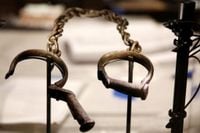As the United States approaches its 250th anniversary, a fierce debate is erupting over how the nation remembers its past—especially the legacy of slavery. At the heart of the controversy stands the Smithsonian Institution, the country’s preeminent museum complex, now facing a sweeping review by the Trump administration. The administration claims the Smithsonian’s Washington museums place too much emphasis on the horrors of slavery, while critics warn that efforts to reframe history threaten not only honest memory but also the foundations of democracy itself.
On August 12, 2025, Lindsey Halligan, special assistant to the president, sent a letter to Smithsonian Secretary Lonnie Bunch announcing a “comprehensive internal review of selected Smithsonian museums and exhibitions.” According to Newsweek, Halligan’s mission is to ensure these institutions reflect what she calls “full context” in their treatment of slavery and American history. “It’s not about whitewashing, it’s about full context, so while slavery is obviously a horrible aspect of our nation’s history, you can’t really talk about slavery honestly unless you also talk about hope and progress and I think we need to be focusing on the progress that we’ve made then and we need to stop focusing so much on the lack of progress,” Halligan said during a Newsmax interview.
The planned review will initially target several major Smithsonian museums, including the National Museum of American History, the National Museum of African American History and Culture, and the National Museum of the American Indian, among others. The administration’s stated goal, as outlined in a letter obtained by The Wall Street Journal and reported by inkl, is to “ensure alignment with the president’s directive to celebrate American exceptionalism, remove divisive or partisan narratives, and restore confidence in our shared cultural institutions.” The timing is pointed: the White House wants the Smithsonian and the nation’s capital to be “beautiful and amazing and a place that all Americans want to come visit” during the 250th anniversary celebrations next July.
President Trump himself has been vocal about his dissatisfaction with the Smithsonian’s current approach. On his Truth Social platform, he described the museum group as “OUT OF CONTROL, where everything discussed is how horrible our Country is, how bad Slavery was, and how unaccomplished the downtrodden have been—Nothing about Success, nothing about Brightness, nothing about the Future.” The administration’s fact-sheet, highlighted by inkl, takes issue with exhibits that mention enslaved people supporting Benjamin Franklin and the role of white settlers defending slavery during the Texas Revolution—events that historians say are critical to understanding the nation’s development.
Supporters of the administration’s campaign argue that the Smithsonian, which is over 70 percent federally funded, should not be a “laboratory for political experiments.” As Halligan put it, “Classrooms shouldn’t be stages upon which teachers can preach their various indoctrination masquerading as eternal truths and similarly museums that are over 70 percent funded by the federal government shouldn’t be laboratories for political experiments.” The White House’s position is that museums must offer a more balanced narrative, highlighting not only the country’s failings but also its achievements and progress since emancipation.
But critics see something far more sinister at play. According to Dallas Weekly, attempts to downplay the horrors of slavery are not just a matter of historical debate—they are a form of psychological warfare and gaslighting. “Slavery was not a job training program. It was theft. Of labor. Of lineage. Of language. Of life. It was not about productivity. It was about ownership. It was the cold-blooded, legally sanctioned, generational abuse of human beings for profit. It was rape, not romance. Terror, not training,” the article states. The piece warns that whitewashing slavery lays the groundwork for future injustices, arguing that “if bondage had benefits… maybe incarceration does too. Maybe the border camps are just summer school. Maybe forced labor behind razor wire is just rehabilitation. Maybe colonization was just a lesson plan.”
Historians and museum professionals have pushed back against the administration’s efforts. Douglas Brinkley, a presidential historian, told The New York Times (as cited by inkl), “It’s the epitome of dumbness to criticize the Smithsonian for dealing with the reality of slavery in America. It’s what led to our Civil War and is a defining aspect of our national history. And the Smithsonian deals in a robust way with what slavery was, but it also deals with human rights and civil rights in equal abundance.” Sarah Weicksel, executive director of the American Historical Association, echoed this sentiment in a statement to Newsweek: “The Smithsonian has an international reputation for the integrity of its research and scholarship, and it is a trusted resource to which teachers turn for high quality educational content. Partisan political intervention into museum professionals’ work stands to erode public trust. The public must have access to a whole and complex history of the American past, not the sanitized and incomplete version preferred by the current administration.”
The Smithsonian itself has responded with cautious professionalism. In a statement to Newsweek, the institution affirmed, “The Smithsonian’s work is grounded in a deep commitment to scholarly excellence, rigorous research, and the accurate, factual presentation of history. We are reviewing the letter with this commitment in mind and will continue to collaborate constructively with the White House, Congress, and our governing Board of Regents.”
This is not the first time the Trump administration has sought to reshape the nation’s historical narrative. During his first term, the president established the 1776 Commission, which produced a report widely criticized by historians for “falsehoods, inaccuracies, omissions, and misleading statements,” as the American Historical Association wrote. The commission was seen as a direct response to The New York Times’ 1619 Project, which placed slavery and racism at the center of the American story. More recently, the administration has restored the names of military bases originally named for Confederate leaders and deleted information about notable African Americans, such as Jackie Robinson, from government sites.
For many, the stakes of this debate go far beyond museum walls. As Dallas Weekly argued, “When Trump or any politician tries to whitewash slavery, they are not engaging in some academic revision of the past. They are wielding language like a blade, slicing at the truth to protect a narrative that keeps the powerful perched high and the rest of us drowning in amnesia.” The article contends that honest memory is necessary for justice and democracy, and that “to whitewash slavery is to whitewash everything that followed. To cleanse the crime scene so the murderer can write the memoir.”
As the Smithsonian’s review unfolds, the nation faces a pivotal question: Will the story it tells about itself be one of courage and truth, or of comfort and erasure? The answer may shape not only the nation’s anniversary celebrations but also its future understanding of freedom, justice, and the price of forgetting.




